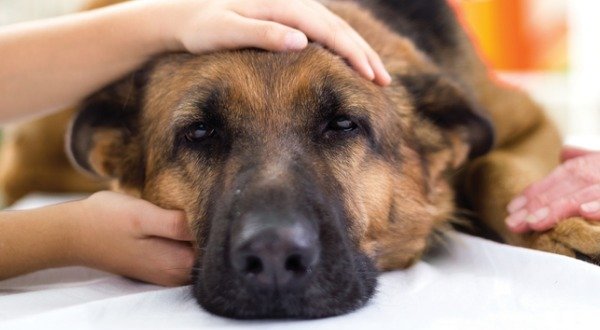If you have been alive for more than a couple of decades, it is very likely that one of your close family members – a human or a pet – has been diagnosed with cancer. Cancer has not been avoided by my family either. My grandmothers died of breast and colon cancer, my father died of prostate cancer, and my brother and my brother-in-law both died of brain tumors.
As a veterinarian, I have seen the cancer rates in people and animals rising, and that is despite billions spent on searching for a cure for cancer. The situation naturally makes one ask… are we barking up the wrong tree with our canine cancer approach?
The Most Effective Canine Cancer Solution
The quest for a cancer cure made me often wonder why so much research focuses on finding a cure instead of prevention and why most people start looking for cancer solutions only after a cancer diagnosis is delivered?
In other areas of life, we do our best to prevent problems and accidents. Car manufacturers focus on increasing car safety through seatbelts, airbags to advanced collision prevention system, and self-driving. Builders strive to make earthquake-proof and fire-proof buildings and design them in such a way as to prevent leaks and weather damage.
Strangely, while most industries focus on problem prevention, the medical system focuses on solving cancer after it happens.
The first reason is that most people have a tendency to put their head in the sand and deal with problems only when they arise. The other reason is that medical companies reap their rewards by treating disease and not by preventing it. This is the main reason why there is so much emphasis on cure instead of prevention.
Perhaps, the current medical system is somewhat better in early diagnosis and cancer treatment than 20 years ago, but more people and animals are dying of cancer than ever before.
In reality, there is little difference between car accidents, leaky buildings, or cancer. The most effective and least expensive solutions are in the area of prevention – despite the medical research and companies’ focus on finding a cure.
Better Ways to Prevent Cancer in Dogs… and People
There are only two ways to create much-needed change in how we approach cancer prevention and treatment in animals and people.
#1 – We must support and reward companies that focus on building health instead of treating disease.
#2 – We need to strive to develop independent research that will focus on cancer prevention.
Preventing cancer would have enormous impact on our quality of life and our animals. Governments would also save money on health care which would allow redirecting funds to solving other issues such as poverty and global warming. Unfortunately, such a system currently does not exist and we have to take cancer prevention in our own hands.
We can find the inspiration to disease prevention in nature. The natural healing cycle is embedded in every living organism.
The body is an electromagnetic system that works best in its purest form. Adding drugs, chemicals, toxins and unnatural level of stress cause the systems to break down and the immune system to fail. Cancer is just a consequence of ignored or unrecognized signals. It is a failure of the body’s defenses.
The Most Common Causes of Canine Cancer
I do not want to discount the effect of genetics on our health and cancer incidence, but cancer genes manifest only when other conditions are present. The most common factors for cancer in dogs are toxins, vaccines, stress, poor diet, and nutritional deficiencies that could be easily corrected by choosing natural essential supplements for dogs.
Perhaps you may be surprised that I mentioned vaccines. I am not saying that vaccines sometimes do not save lives, but they are overused. I am especially against combination vaccines because they expose the body to multiple pathogens (antigens) at once. Such vaccines overwhelm the immune system, making it fail to prevent cancer. Over the years, I have come up with an alternative vaccination protocol that still keeps animals safe but dramatically reduces the risk of side effects.
Other reasons why doctors do not pursue cancer prevention more daringly are government restrictions and veterinary college regulations. I sometimes joke that a good veterinarian has to lose the fear of losing their license because so many effective treatments are not approved by the conventional medical authorities.
In a way, the regulatory bodies are barking up the wrong tree because the true danger lies in overuse of toxic drugs and chemicals that “suppress” the disease symptoms without addressing the actual disease cause. This approach poisons and weakens the body, leading to immune system failure and a higher rate of cancer in general. This is why a detox protocol should be a part of cancer prevention.
Are Radiation & Chemo a Good Choice for Dogs With Cancer?
People often ask me whether chemotherapy, surgery, and radiation are indicated in canine cancer treatment. The biggest problem is that these big three are seen as the first line of defense. During 30 years in practice, I have treated many dogs with cancer. Some guardians choose one of the big three and others do not.
The interesting part is that the pet patients who have NOT received these invasive treatments generally do as well or better than the patients that receive chemo, radiation, and surgery.
I do not deny the fact that sometimes these treatments make patients survive, but I have also seen many disappointing outcomes and heartbreaks. Logically, there must be something better than “poisoning” or radiating the body at a time when it is already weakened.
Every person, every animal lover has to decide on their own what to do. When it comes to my animals, I prefer doing as much as I can on the preventive level, and it can start with a simple questionnaire about your pet’s current health.
And if cancer happens despite my best efforts, I would not choose chemotherapy or radiation for my dog. I firmly believe no dog would select chemo or radiation if they had a choice. It is us who have to come to peace with the reality of life. No matter how long our beloved animal friends live, it will never be long enough and they will die of one cause or another.
I hope that as time progresses, we will be able to find better and more efficient ways to treat cancer and further extend the lives of our animal friends. However, until such methods are available, the best canine cancer treatment is prevention.
Steps include a natural diet, supplements to improve cellular and organ health, detoxing the body, and promoting the energy flow by increasing strength, flexibility, and addressing injuries. The Healing Cycle is a good example of such an approach.
Article Summary
Most people start looking for cancer solutions only after a cancer diagnosis is delivered.
Our medical system focuses on solving cancer after it happens.
The most effective and least expensive solutions are in the area of prevention.
Cancer is a consequence of ignored or unrecognized signals.
The true danger lies in overuse of toxic drugs and chemicals that “suppress” the disease symptoms without addressing the actual disease cause.
The best canine cancer treatment is prevention.



















My dog has just been diagnosed with T-cell lymphoma. He is 14 years old. Our vet wants to do chemo. We want to do what is best for Patches. My research tells me he will only live 6-8 weeks with no treatment. What would you suggest as the best course of action? I would very much appreciate a quick response, as we are watching this disease advance every day. Thank you.
We currently have a cocker spaniel dog who is almost 9 years old. My husband and I are firm believers that part of many pet illnesses come from the food they. There is no regulation in pet food we are aware of.
Lily developed severe eye and ear allergies which turned into her while becoming palsey. After a year and a half and $4,000 in vet bills later we decided to try a high quality raw food diet! Within one day Lily showed improvement and in five days she was perfect. 3 weeks later at the vet visit we were informed….the new kibble diet is working!!! It was the kibble at all!!!! It was the result if the raw food diet. We have never looked back. Today Lily is a very healthy dog and has no ear or eye infections. She was perfect at her recent check up. We believe regular kibble has huge potential to cause cancer.
Thanks for all you do to promote this cause.
Hi Souzann –
Thank you so much for sharing your experience with us.
I’m sure this will inspire many pet parents. We believe that REAL and nutritious foods are the best solution for humans and animals. 🙂
Blessings and love!
My dog Duke who was a Golden Retriever was diagnosed with cancer in the bum at age 11. The vets did surgery, but it was too late. The cancer spread in many parts of the body and his bum started bleeding. He had to be put down in the end.
11 is considered a long life for goldens, esp since the majority of them are said to die of cancer by 10. Mine died at 11 of enlarged heart, but mostly I avoided a lot of the dangers and cooked her meals and fed a good quality kibble mixed with it. Surgery can often cause it to spread. We should stop saying “put down” of our animal companions. It is very callous. What we are actually doing is helping them leave the world of pain and suffering.